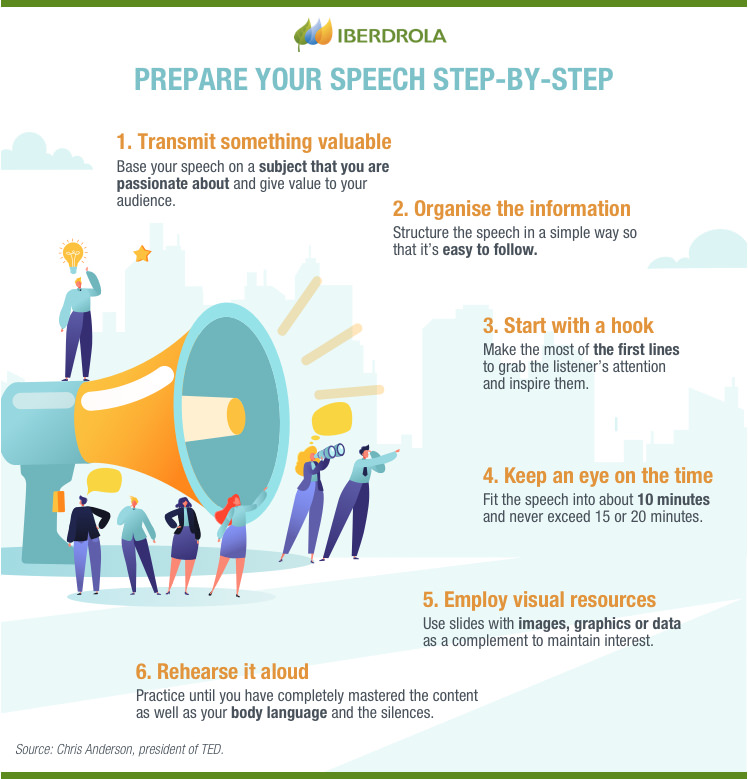How to deliver a motivational speech?
Motivational speaking or the inspiring power of words
Leadership High performance Professional skills
Motivational speech is art made into words, a powerful resource that goes beyond simply speaking well. What is its objective? To encourage reflection or influence convictions by appealing to our emotions. Some speeches, such as Martin Luther King's I have a dream, are proof that words can change history.

Public speaking skills
Public speaking is a highly sought-after talent in the fields of business, politics, education and sport because it is associated with leadership. People who know how to communicate well have more capacity to connect with their environment, unite teams and instil values. However, this skill, which for some people comes naturally, can be an uphill struggle for others. According to Verywell, a website created by health experts, 75% of the world's population are afraid to speak in public.
Motivational speaking, which turns a mere talk into an inspiring story, is the kind of speech that any speaker would aspire to when they stand in front of dozens of people. It is, without doubt, the most complicated type of public speaking and it requires a higher level of oratory. But we don't need to get hung up about achieving this level because it is not always the best approach. Before delivering a speech, you have to make an assessment of the target audience and what objectives you want to achieve. In the following, we will review this and also share some alternatives:
 Motivational
Motivational
Motivational speaking conveys a highly emotional message and its purpose is to invite action. It is characteristic of very charismatic leaders and it's useful in dealing with difficult times or a great deal of uncertainty.
 Persuasive
Persuasive
The objective of this is to convince the listener to change their mind or to act in a certain way. It is a common resource in politics, advertising and sales marketing.
 Informative
Informative
This offers information and interesting data to the audience. It's useful for presenting research projects, demonstrating results or providing training resources for colleagues within your company.
 Entertainment
Entertainment
It is an address aimed at entertaining the audience. It is usually carried out in a relaxed context, but that does not mean it should not be void of content. Valuable information can be imparted with a dose of humour.
Nowadays, there are tools to complement and enhance speeches at a visual level. These IT programs when properly harnessed, can become excellent partners in winning over the audience and gaining their applause. The following are some of the best-known programs:
- Prezi. This program stands out visually for the originality of its transitions, something which is very useful when structuring content and linking ideas. It is accessible online and stored on the cloud, facilitating access to presentations.
- Keynote. This software, which can only be accessed on Apple technology platforms, is the most powerful and sophisticated program to use when requiring visual effects and other multimedia tools. It allows audio files to be recorded and edited and diagrams or illustrations can be hand drawn using the Apple Pencil.
- PowerPoint. For years it was the most used, but the appearance of other alternatives and the lack of updates took away its protagonism. It is the easiest program to use and the most appropriate for creating performances that require less visual impact, such as presenting results.
The most motivating speeches
There are speeches that, due to their content and the context in which they were made, have changed the course of history. Below are some examples of the most inspiring speeches:
- The Gettysburg Address, Abraham Lincoln (Gettysburg, 1863). The president of the USA defended, in just a few short minutes, freedom, democracy and the premise that all men are equal.
- We shall fight on the beaches! Winston Churchill (London, 1940). When the Nazi advance seemed unstoppable, the British prime minister made a speech that raised the morale of an entire country.
- I have a dream, Martin Luther King (Washington, 1963). A pacifist argument against racism that raised consciences in the 60s and earned King the Nobel Peace Prize a year later.
- How to live before you die, Steve Jobs (Stanford University, 2005). The creator of Apple, by means of an emotional personal account, invited students to be passionate about everything they undertake.
- Yes we can, Barack Obama (New Hampshire, 2008). The candidate for the USA presidency, who inspired hope throughout the country and the whole world with a speech that became his campaign slogan.

 SEE INFOGRAPHIC: Prepare your speech step by step [PDF] External link, opens in new window.
SEE INFOGRAPHIC: Prepare your speech step by step [PDF] External link, opens in new window.
Tips for public speaking
As already mentioned, delivering a motivational speech is not an easy task. So, when sitting down to write it, bear in mind the following recommendations:
 Write as you would speak
Write as you would speak
There are phrases that on paper might sound great but when spoken aloud can be grandiloquent and they should be avoided. The only way to prove that we have written a natural speech is to read it out load as we write it.
 Tell a story and be authentic
Tell a story and be authentic
A speech must sound convincing, so commit to not making anything up, and instead, draw on your own experiences. Key objectives to aim for are an introduction that conveys closeness, then develop that to form a highly meaningful connection, and finish with an inspiring conclusion.
 Create a preliminary structure
Create a preliminary structure
Before sitting down to write a motivational speech, jot down on a notepad the main points you want to get across, to make it easier to flesh it out and give it meaning. If the argument is clear and ordered, it will be more persuasive.
 Summarise your message
Summarise your message
Summarising what you want to say is the most complex part. To do this, focus on producing a direct message and not repeating any concepts. Otherwise, it is very likely that your audience will get bored and disconnect.
 Control non-verbal communication
Control non-verbal communication
Sometimes it is not enough to be a good speaker, you have to know how to convey the message to move your audience. Non-verbal communication plays an important role, so be aware of gestures, the tone of your voice and the silences.
The elevator pitch or how to get your message across in a few seconds
How thinking outside the box could improve your organisation




